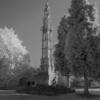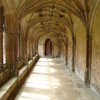Experimenting with Infra-Red photography. |
Story location: Home / photography / gallery / |
| 14/Oct/2012 |
Many years ago I experimented with Infra-red photography using black and white film which was made by Konica and was sensitive to the longer wavelengths. The film was relatively insensitive to some visible wavelengths and I worked out that I could use an orange filter to get a decent Infra-red effect where foliage came out bright and the sky was dark. A couple of the photos are shown here.
Last week I decided to have another go but this time using my digital camera so I ordered a set of filters. These block visible light and only let through longer wavelengths. The sensors used in digital cameras are all sensitive to infra-red light but the cameras also include infra-red blocking filters, otherwise normal daytime photos will have a various amounts of IR light potentially bleeding through into the picture.
A bit of research on the web suggested that older cameras work better than newer ones since newer cameras have thicker or more effective filters. My Nikon D40 should work but will require fairly long exposures to compensate for the IR blocking filter.
This morning I took my camera, filters and tripod for a walk. The filters start at 720nm, which is deep red, right at the end of visible light. Looking through this filter, you can just about see bright light sources. The other filters are 760nm, 850nm and 950nm. These block all visible light and only let through progressively longer wavelengths.
Photos taken with the 720nm filter show a moderate IR effect, similar to photos taken with the Konica film I had previously used. Blue skies are darkened, a bit like a normal red filter with standard black and white film, and Foliage appears bright. With the longer wavelength filters, the sky gets darker which increases the contrast between it and any IR reflecting objects in the scene, such as leaves or stone.
I was surprised to find that the autofocus still worked using the 720nm filter. I focused at the start of each test then locked the focus on the lens (by setting the camera to manual focus but leaving the lens in autofocus) so I didn't check whether focus worked with the other filters. The camera's metering worked with all the filters but I had to add an extra stop or two of exposure compensation.
A tripod is essential when using these filters, since the exposure went from 1/200s with no filter, to around 1s with the 720nm filter, up to 15-20s with the 950nm filter. If I only carried one filter around with me, it would be the 760nm. The IR effect is stronger than the 720nm filter but the exposure is only slightly longer, at around 2-4 seconds.





Click on the thumbnail to view the image
Lacock Village and Abbey |
Story location: Home / photography / gallery / |
| 27/Apr/2008 |
Lacock Village would have been picturesque if they hadn't ruined it by filling the high street with cars.
Lacock Abbey was interesting. This was the home of William Henry Fox Talbot, the inventor of the photographic negative, which allowed multiple prints to be made of a single image.






Click on the thumbnail to view the image
Photo Gallery |
Story location: Home / photography / gallery / |
| 19/Jan/2005 |
An assortment of my photos from over the years. Viewing each photo will bring up details of location and sometimes the film used. Two of the photos (Nether Alderley Mill and Christchurch) were taken using Infra-red film.


















Click on the thumbnail to view the image
Concert Photos |
Story location: Home / photography / gallery / |
| 19/Jan/2005 |




Click on the thumbnail to view the image
